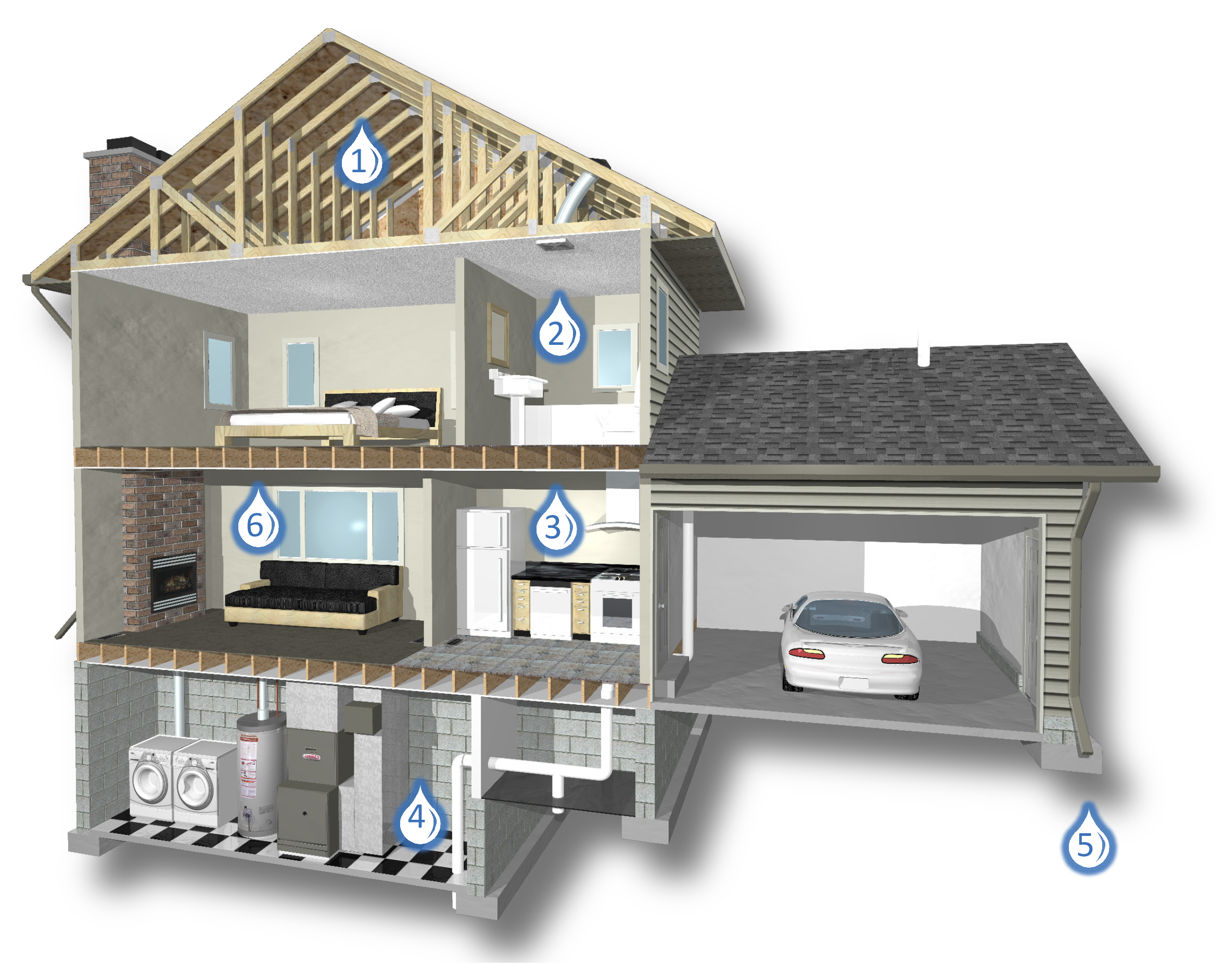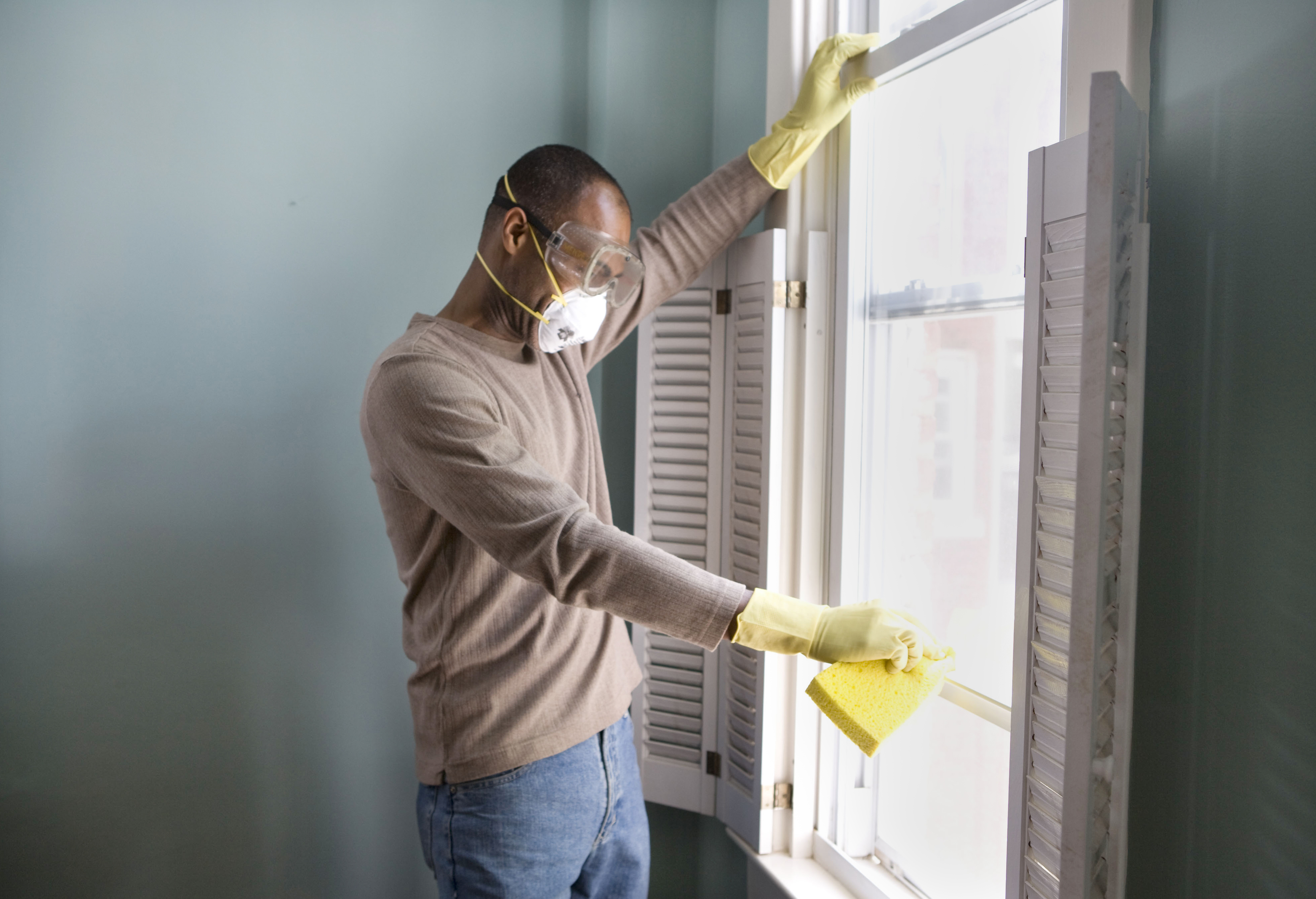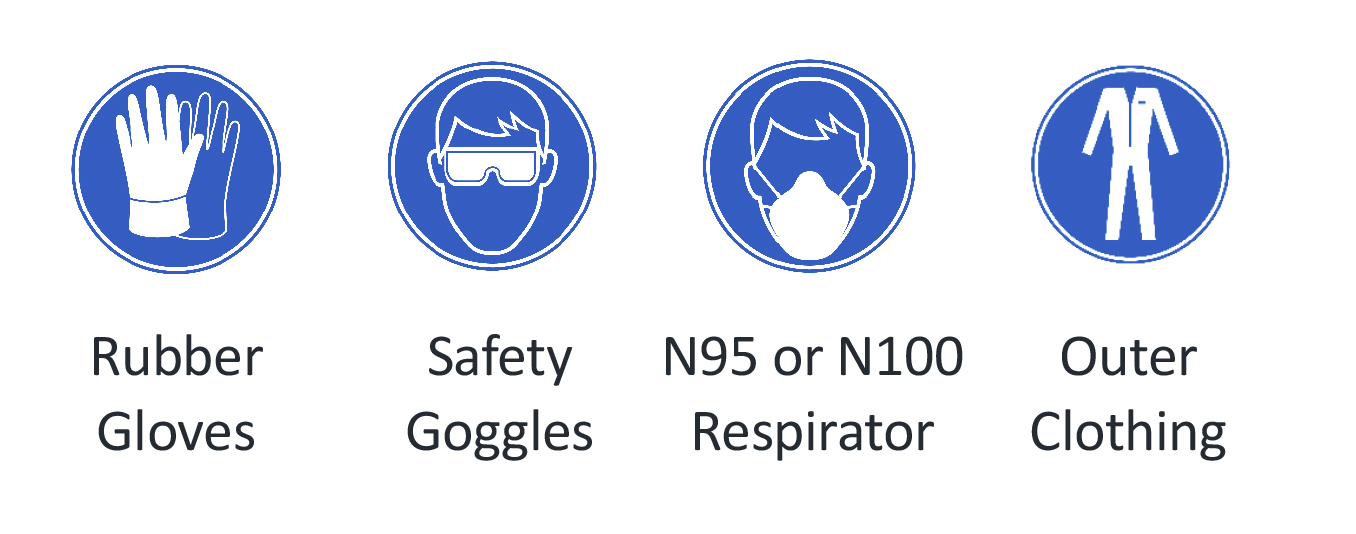Mold & Moisture
Related Topics
Environmental Health Division
Mold and Moisture

Download a printable version of the brochure:
Mold & Moisture: Keeping your home free from mold and moisture problems (PDF)
Mold is a type of fungus. Mold spores are found in both the indoor and outdoor air, but they will only grow if they find the right conditions. Mold requires three simple elements to grow:
- Moderate temperatures.
- Nutrients (food).
- Moisture.
Mold can start to grow on interior building surfaces and furnishings if there is too much moisture. Eventually, the mold will damage the materials it is growing on and may cause health effects for occupants.
Mold and your health
Health effects from mold can vary greatly from person to person. Common symptoms can include coughing, runny nose, wheezing and sore throat. People with asthma or allergies may notice their symptoms worsen.
All molds are a potential health hazard
Many molds are capable of producing substances that can be harmful to your health. Molds can produce allergens and irritants that can cause illness. For this reason, all indoor mold growth should be removed promptly, regardless of the type of mold present.
Some people may have more severe reactions
- Children.
- Individuals with respiratory conditions or sensitivities such as allergies or asthma.
- Persons with conditions severely weakening their immune systems (for example, people with HIV infection, chemotherapy patients, organ transplant recipients).
Anyone with concerns about health effects from a moldy environment should contact their medical provider.
Home investigation
The most practical way to find a mold problem is to simply use your eyes and nose to find signs of excess moisture and mold growth. If you see or smell mold, you should assume that a problem exists.
Look for signs of moisture or mold
- Mold can have a cottony, velvety, granular or leathery texture.
- The color of mold can vary from white, gray, brown, black, green or other colors.
- Mold damage may look like discoloration or staining on the surface of building materials or furnishings.
- Noticeable mold odors are described as musty or earthly.
Look for signs of water damage or excess moisture
- Water leaks.
- Standing water.
- Water stains.
- Condensation problems.
Search behind and underneath furnishings, stored items, and building materials (For example, under carpet and pad, wallpaper, vinyl flooring, sink cabinets, or dry wall)
Mold and water can show up in many places

- Leaking roofs and ice dams.
- High humidity in bathrooms and kitchens.
- Leaking pipes.
- Flooding in basement.
- Pooling water at foundation.
- Condensation on windows and exterior walls.
Moisture in your home
Mold needs water to grow. Controlling moisture in your home is the best way to prevent mold problems.
Repair leaks and spills quickly
- Periodically check plumbing, roofing, foundations, gutters, attics, crawl spaces, and sump pumps.
- Dry wet materials in 24-48 hours to avoid mold growth.
- Insulate and seal air leaks between attic and house to prevent ice dams.
Divert water away from the house
- Clean and maintain gutters.
- Slope the ground and sidewalks away from foundation.
- Install and use a sump pump.
Reduce condensation
- Install and use exhaust fans in bathrooms and kitchens that are ducted to the exterior.
- Vent appliances (water heaters, gas fireplaces, furnaces, clothes dryer) outside.
- Insulate or seal cold spots (For example: water pipes).
- Reduce the use of humidifiers.
- Raise the temperature and increase the air circulation to colder parts of the home.
To keep indoor surfaces as dry as possible, try to maintain the home's relative humidity between 20-40 percent in the Winter and less than 60 percent the rest of the year. You can purchase devices to measure relative humidity at some home supply stores. Ventilation, air circulation near cold surfaces, dehumidification, and efforts to minimize the production of moisture in the home are all very important in controlling high humidity that frequently causes mold growth in our climate.
Mold testing
Many people want to test their home for mold. In most situations, MDH does not recommend mold testing. There are several reasons for this:
1. Proper mold testing is expensive - If you can see or smell mold in your home, you know you have a mold problem. There are several ways to test for mold, and each test has different advantages. In order to get a good idea of a mold problem, several types of tests are needed. It is usually better to use the money you would spend on testing to solve the moisture issues and clean up mold.
2. There is no health-based standard for mold levels in air- Everyone reacts differently to mold and there is not enough research available to determine how much mold is “safe”.
3. Any mold growing inside is a problem it does not matter what specific type of mold is present - Consider any type of mold growing indoors a potential health hazard. It doesn’t matter if it is black, red or green, any mold indoors is a problem.

There are rare situations where testing may be valuable. For some circumstances, testing may confirm mold growth or document clean-up has met expectations. In these cases it is important to use a skilled investigator who will interpret the results for you and help you reach a decision. Testing should never be a substitute for a good visual inspection.
- For more information see MDH Testing for Mold.
Mold removal
In many cases, cleaning up mold can be a do it yourself project.
Protect yourself
Wear personal protective equipment (PPE) when handling or working around contaminated materials. The following equipment should be considered:

Review your health status, and if you cannot use a respirator or have sensitivity to mold, consider hiring a mold remediation professional.
Protect others and the building
If you decide to clean the mold yourself, it is important to protect yourself and the other people in the building. When cleaning a large amount of mold, consider the following:
- Remove furnishings and items from the work area.
- Enclose and seal mold material in plastic (bags or sheets work) before carrying them through the home.
- Separate the work area from the rest of the home using plastic sheeting.
- Cover air supply and return vents in the work area.
- Use a fan to pull contaminated air out of the work area and exhaust it outdoors.
- Consider renting an air scrubber to operate in the area (available at cleaning supply companies or neighborhood rental shops).
- Remove the outer layer of work clothing inside the work area and wash separately, or bag and discard the clothing.
Clean-up steps
1. Identify and Fix the Moisture Problem - This is the most important step. If you don't correct the moisture problem the mold will likely return.
2. Dry Wet Materials - Begin drying wet areas as soon as possible. This task can be done with the use of wet/dry vacs, dehumidifiers and fans. Materials dried within 24-48 hours will often not have a chance to grow mold. Porous materials contacted by sewage should always be removed.
3. Remove Mold Growth - Your approach depends on the type of material or surface contaminated.
- Porous materials: Items like carpet, drywall, insulation and paper should be bagged and thrown away if they are growing mold.
- Non-porous materials: Items made of hard plastic, solid wood, concrete, metal, or glass can be cleaned if they are structurally sound.
Cleaning steps include:
- Scrub surfaces with a stiff brush, hot water and household detergent. The goal is to remove the physical mold growth.
- Collect any cleaning solution. (For example, with a wet/dry vacuum, sponge or mop).
- Rinse area with clean water.
- Dry the area completely.
4. Optional Treatment with Bleach - After cleaning has removed the mold growth, bleach may be used to kill mold missed by Step 3. Always handle bleach with caution. Never mix bleach with other chemicals and only use it in a well-ventilated area. Protect your eyes and skin from solution.
If the water damage and mold growth are due to overland flooding or sewage back-up, then use bleach.
- Dilute 1/4 to 1/2 cup bleach per 1 gallon of water.
- Apply to the area with sponge or rag, taking care not to oversaturate the surface.
- Collect any excess bleach solution.
- Allow at least 30 minutes before wiping off the surfaces with water.
- Dry the area completely.
5. Remain on Mold Alert - Keep an eye out for signs of moisture problems or mold growth. If mold returns, fix the moisture problem and repeat the cleaning steps again.
6. Rebuilding - Reconstruction needs to wait until the affected areas are completely dry. This may take several days, weeks or even months.
Ozone air cleaners
Some air cleaners are designed to produce ozone which is a strong oxidizing agent and a known irritant of the lungs and respiratory system. Studies have shown that ozone, even at high concentrations, is not effective at killing airborne mold or surface mold contamination. Even if mold was killed by ozone, the health threats would not be reduced until mold contaminants are removed through cleaning. Health experts, including the Minnesota Department of Health, do not recommend the use of ozone to address mold or any other indoor air problems.
Resources
The MDH does not provide inspection or testing services. MDH provides technical advice by phone and email, and advises people to investigate potential mold problems on their own first. Homeowners can hire indoor air quality service providers to assist them in investigating and remediating mold. These professionals may have tools such as moisture meters, scoping cameras and infrared cameras that may be useful in an investigation. There are also mold remediation professionals that specialize in cleaning and removing mold. Neither the state of Minnesota nor any federal agency licenses or certifies mold investigators or remediators.
- MDH Guidelines for Selecting an Indoor Air Quality Consultant
- Environmental Protection Agency (EPA) Mold
- Centers for Disease and Control Prevention (CDC) Mold
- University of Minnesota Extension Service Moisture in Basements: Causes and Solutions
Renters
Generally, the landlord is responsible for controlling moisture problems and removing mold, unless it is an issue related to the tenant's behavior. Renters can address some minor moisture problems themselves.
Tenants and landlords should work cooperatively to investigate and correct moisture and mold problems. If the owner is unwilling to help, the renter may seek outside advice. MDH does not inspect rental properties. How local agencies respond to complaints varies throughout the state.
If the case cannot be addressed with a local building, housing or health inspector, a renter may wish to contact an attorney or tenants' organization to discuss legal options.
- For more information see MDH Mold in Rental Housing.